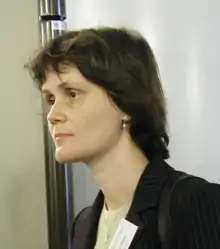Cornelia Druțu
Cornelia Druțu is a Romanian mathematician notable for her contributions in the area of geometric group theory.[1] She is Professor of mathematics at the University of Oxford[1] and Fellow [2] of Exeter College, Oxford.
Cornelia Druţu | |
|---|---|
 | |
| Born | |
| Alma mater | Université Paris-Sud XI University of Iași |
| Awards | Whitehead Prize (2009) |
| Scientific career | |
| Fields | Mathematics |
| Institutions | University of Oxford University of Lille 1 |
| Doctoral advisor | Pierre Pansu |
Education and career
Druțu was born in Iaşi, Romania. She attended the Emil Racoviță High School (now the National College Emil Racoviță[3]) in Iași. She earned a B.S. in Mathematics from the University of Iași, where besides attending the core courses she received extra curricular teaching in geometry and topology from Professor Liliana Răileanu.[2]
Druțu earned a Ph.D. in Mathematics from University of Paris-Sud, with a thesis entitled Réseaux non uniformes des groupes de Lie semi-simple de rang supérieur et invariants de quasiisométrie, written under the supervision of Pierre Pansu.[4] She then joined the University of Lille 1 as Maître de conférences (MCF). In 2004 she earned her Habilitation degree from the University of Lille 1.[5]
In 2009 she became Professor of mathematics at the Mathematical Institute, University of Oxford.[1]
She held visiting positions at the Max Planck Institute for Mathematics in Bonn, the Institut des Hautes Études Scientifiques in Bures-sur-Yvette, the Mathematical Sciences Research Institute in Berkeley, California. She visited the Isaac Newton Institute in Cambridge as holder of a Simons Fellowship.[6]
She is currently chair of the joint scientific committee of the European Mathematical Society and European Women in Mathematics.[7]
Awards
In 2009, Druțu was awarded the Whitehead Prize by the London Mathematical Society for her work in geometric group theory.[8]
In 2017, Druțu was awarded a Simons Visiting Fellowship.[6]
Publications
Selected contributions
- The quasi-isometry invariance of relative hyperbolicity; a characterization of relatively hyperbolic groups using geodesic triangles, similar to the one of hyperbolic groups.
- A classification of relatively hyperbolic groups up to quasi-isometry; the fact that a group with a quasi-isometric embedding in a relatively hyperbolic metric space, with image at infinite distance from any peripheral set, must be relatively hyperbolic.
- The non-distortion of horospheres in symmetric spaces of non-compact type and in Euclidean buildings, with constants depending only on the Weyl group.
- The quadratic filling for certain linear solvable groups (with uniform constants for large classes of such groups).
- A construction of a 2-generated recursively presented group with continuously many non-homeomorphic asymptotic cones. Under the Continuum Hypothesis, a finitely generated group may have at most continuously many non-homeomorphic asymptotic cones, hence the result is sharp.
- A characterization of Kazhdan's property (T) and of the Haagerup property using affine isometric actions on median spaces.
- A study of generalizations of Kazhdan's property (T) for uniformly convex Banach spaces.
- A proof that random groups satisfy strengthened versions of Kazhdan's property (T) for high enough density; a proof that for random groups the conformal dimension of the boundary is connected to the maximal value of p for which the groups have fixed point properties for isometric affine actions on spaces.
Selected publications (in the order corresponding to the results above)
- Druţu, Cornelia (2009). "Relatively hyperbolic groups: geometry and quasi-isometric invariance". Commentarii Mathematici Helvetici. 84: 503–546. arXiv:math/0605211. doi:10.4171/CMH/171. MR 2507252..
- Behrstock, Jason; Druţu, Cornelia; Mosher, Lee (2009). "Thick metric spaces, relative hyperbolicity, and quasi-isometric rigidity". Mathematische Annalen. 344 (3): 543–595. arXiv:math/0512592. doi:10.1007/s00208-008-0317-1. MR 2501302.
- Druţu, Cornelia (1997). "Nondistorsion des horosphères dans des immeubles euclidiens et dans des espaces symétriques". Geometric and Functional Analysis. 7 (4): 712–754. doi:10.1007/s000390050024. MR 1465600.
- Druţu, Cornelia (2004). "Filling in solvable groups and in lattices in semisimple groups". Topology. 43 (5): 983–1033. arXiv:math/0110107. doi:10.1016/j.top.2003.11.004. MR 2079992.
- Druţu, Cornelia; Sapir, Mark (2005). With an appendix by Denis Osin and Mark Sapir. "Tree-graded spaces and asymptotic cones of groups". Topology. 44 (5): 959–1058. arXiv:math/0405030. doi:10.1016/j.top.2005.03.003. MR 2153979.
- Chatterji, Indira; Druţu, Cornelia; Haglund, Frédéric (2010). "Kazhdan and Haagerup properties from the median viewpoint". Advances in Mathematics. 225 (2): 882–921. CiteSeerX 10.1.1.313.1428. doi:10.1016/j.aim.2010.03.012. MR 2671183.
- Druțu, Cornelia; Nowak, Piotr W. (2017). "Kazhdan projections, random walks and ergodic theorems". Journal für die reine und angewandte Mathematik. 2019 (754): 49–86. arXiv:1501.03473. doi:10.1515/crelle-2017-0002.
- Druțu, Cornelia; Mackay, John (2019). "Random groups, random graphs and eigenvalues of p-Laplacians". Advances in Mathematics. 341: 188–254. doi:10.1016/j.aim.2018.10.035. MR 3872847.
Published book
- Druțu, Cornelia; Kapovich, Michael (2018). Geometric Group Theory (PDF). American Mathematical Society Colloquium Publications. 63. Providence, RI: American Mathematical Society. ISBN 978-1-4704-1104-6. MR 3753580.
See also
- "MathSciNet". Retrieved October 31, 2010.
- "ArXiv.org". Retrieved October 31, 2010.
- Cornelia Druţu. "Papers". Retrieved October 31, 2010.
- Geometric Group Theory
- Ultralimit
- Tree-graded space
- Kazhdan's property (T)
References
- Cornelia Druțu. "Cornelia Druţu's Homepage".
- Exeter College, Oxford. "Professor Cornelia Druțu".
- "the National College Emil Racoviță".
- Cornelia Druțu at the Mathematics Genealogy Project
- Cornelia Druțu. "Habilitation Cornelia Druțu".
- "Simons Visiting Fellowships".
- "EMS/EWM Scientific Committee". 2008-03-22.
- London Mathematical Society. "Prize Winners 2009". Archived from the original on 2009-10-23. Retrieved 2010-10-31.